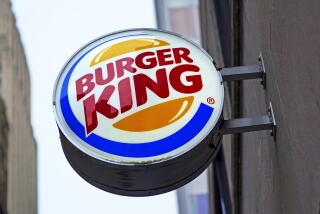Clawing to Become Top Dog of Pet Food
An increasingly bitter fight is building along the pet food aisle, as some of the best-known consumer goods companies scramble for increased share in the $30-billion worldwide market for pet food.
The ongoing consolidation is reshaping how and where pet supplies are sold and leading to a widening array of pet foods, supplements, treats and accessories--not to mention a rising level of rivalry.
Procter & Gamble Co. entered the fray in 1999 with the $2.05-billion acquisition of premium pet food manufacturer Iams Inc. The consumer goods giant immediately pushed Iams beyond specialty pet stores where it long had been sold and into grocery stores and mass merchants, which sell 70% of the nation’s pet food.
Among the responses from competitors Kal Kan Foods Inc. and Nutro Inc. were lawsuits alleging that P&G; engaged in a misleading marketing campaign that attempted to make the pricier Iams brand seem less expensive by reducing the recommended daily amounts of certain Iams chows. Los Angeles resident Karen Pollack on July 26 filed suit in Superior Court in Los Angeles seeking unspecified damages after her dog, Ally, allegedly lost more than 4 pounds while following Iams’ feeding guidelines.
Kal Kan’s suit includes what the company describes as independent feeding trials alleging that dogs fed according to Iams’ instructions won’t receive sufficient nutrition. Sources in the industry say the FDA has questioned Iams about the revised feeding instructions, though an FDA spokeswoman said only that the agency “is aware of the lawsuits.”
Iams executives deny that the feeding instructions are inappropriate and say the allegations in the lawsuits are without merit.
The influx of consumer goods giants and the legal wrangling are part of a changing competitive environment. “Five or six major manufacturers now have 70% to 80% of the market,” said Philip Francis, chairman, president and chief executive of the 660-store PetSmart chain. “That’s clearly more concentration than there used to be.”
Mars Inc., which owns the Kal Kan, Pedigree and Whiskas brands, last summer agreed to pay $730 million for premium French pet food company Royal Canin.
Nestle, which owns Friskies and Alpo, is buying Ralston Purina for $10.3 billion, a deal that would make pet chow the company’s second-largest business behind chocolates.
And Colgate-Palmolive Co. acquired the Hill’s Pet Nutrition premium brand in the 1980s.
Pet food makers are counting on revenue and profit growth not only from leveraging their distribution and marketing channels but also because dog and cat populations are on the rise. It doesn’t hurt that many pets are obese.
More than 25% of dogs examined during veterinary office visits are obese. Many pets don’t get enough exercise, and veterinarians say owners often don’t measure accurately--if at all--when filling chow bowls. Americans also spend freely for pet food supplements and store-bought treats and feed their pets table scraps.
Amount of Ingredients Is Unregulated
Whether it’s toothpaste, laundry detergent or a 50-pound bag of dog chow, manufacturers struggle to differentiate their products. The resulting advertising and marketing blitz has created a baffling array of choices for owners of the nation’s 58 million dogs and 71million cats.
The Food and Drug Administration, which regulates dog and cat foods--but not the growing number of supplements and treats--acknowledges that “choosing a pet food from among the cans, bags and boxes stacked on store shelves can be a daunting experience,” according to an article in the most recent issue of the agency’s FDA Consumer magazine.
Manufacturers are required to list ingredients contained in their feeds. But manufacturers don’t have to say what percentage of the product is, say, liver or chicken. Pet food manufacturers also are allowed to incorporate animal byproducts into their chows. The broad category includes the heads, feet and other parts of cattle, swine and fish, according to the FDA.
Some veterinary researchers suggest that manufacturers haven’t conducted sufficient research into the nutritional value of animal byproducts. The Pet Food Institute counters that animal parts are “an important source of protein, carbohydrates, vitamins, minerals and essential amino acids.”
The industry trade group also rejects animal activists’ claims that bodies of dead pets are processed into pet chow. Manufacturers “have gone to extreme measures to make sure that no ingredients from dogs or cats go into their products,” according to the institute.
The FDA, which works with the Assn. of American Feed Control Officers to develop nutritional standards, recommends that consumers check nutritional guidelines contained in “life stage information” printed on labels. Those guidelines tell whether the pet food is designed to meet the nutritional needs of puppies, lactating dogs or other grown animals.
“If you look at ingredient lists, you’re not going to find a lot of differences, so a lot of it comes down to marketing,” said Rodney J. Noel, chairman of the association’s pet food committee. “All of the manufacturers try to stretch your imagination a little bit, so if you believed everything you read on a pet food label, you’d also believe in Santa Claus.”
A History of Trading Advertising Punches
Pet food manufacturers and the consumer goods giants that own them have a long history of trading punches over advertising claims.
When conflicts arise, the first stop typically is the Better Business Bureau’s National Advertising Division, which acts as an advertising industry referee. Pet food companies lodged nearly a dozen advertising complaints during the 1990s. Most of the complaints deal with perceived taste issues or advertising that disparages a competitor’s product.
In May 2000, for example, Nestle complained when Kal Kan claimed that its Whiskas Homestyle Favorites in FlavorLock Pouches tasted better than Nestle’s canned dog foods. A year earlier, Ralston demanded that H.J. Heinz Co. halt its claim that its Kibbles ‘n Bits Lean Dog Food had “10% less fat than [Ralston’s] Fit & Trim.”
Rising Stakes Intensify Competition
Advertising disagreements seem to have grown in intensity as the stakes have risen.
Iams in November filed suit against Nutro for allegedly illegal marketing practices. The lawsuit was sparked by what Iams Vice President Bryan Brown described as “trash talking” by Nutro employees who frequently travel to stores to meet customers. Nutro countered a month later with its own suit, alleging that Iams employees were “harassing, confronting, intimidating and disrupting” Nutro’s marketing teams.
Nutro’s lawsuit also alleges that Iams reduced the recommended feeding portions in order to market its chows as a lower-cost alternative. Discovery proceedings recently began in the lawsuit that alleges false advertising. The suit seeks unspecified damages.
Kal Kan in February filed a separate lawsuit against P&G; and Iams, alleging false advertising in conjunction with the new, reduced feeding recommendations.
Discovery proceedings have yet to begin in the case, filed in federal court in Ohio. A ruling is expected soon on an Iams motion to have the suit dismissed. The suit, which alleges false advertising, seeks unspecified damages.
“Iams has a good food, but it’s an expensive food,” said an attorney representing Kal Kan. “Consumers are being led to think that they’re getting a Mercedes for a Buick price ... but they end up paying the full Mercedes price.”
The two suits by competitors and the civil suit filed in Los Angeles focus on feeding instructions printed on Iams products. The guidelines, like those printed on competing products, tell how much product is needed to meet an animal’s nutritional needs.
Feeding Guidelines Not Ironclad
Each manufacturer bases feeding guidelines on feeding trials or calculations that indicate how much feed is needed to meet FDA and Assn. of American Feed Control Officers nutrition guidelines. Feeding instructions vary from product to product, based on nutritional value.
One set of feeding instructions at issue in the Nutro and Kal Kan lawsuits involves Iams Chunks, an adult dog food. The previous instructions recommended a daily meal of 2 to 21/2 cups; revised instructions suggest 11/2 to 13/4 cups. Brown characterized the change as “a fractional amount.”
Iams maintains that its feeding instructions are safe for pets. “We’re proud of our science and have confidence in our feeding guidelines,” Brown said.
“The allegations are not only false, but in a way they defy common sense,” he added. “Why would a pet food company recommend that consumers feed their dogs less food? Iams made that [feeding instruction] recommendation to enhance the health and well-being of dogs.”
Feeding guidelines aren’t ironclad, according to veterinarians. The Waltham Centre for Pet Nutrition in London, for example, notes that “feeding recommendations are only ever given as guidelines and are subject to individual variability between dogs and to differences in activity level and environmental conditions.”
More to Read
Inside the business of entertainment
The Wide Shot brings you news, analysis and insights on everything from streaming wars to production — and what it all means for the future.
You may occasionally receive promotional content from the Los Angeles Times.









